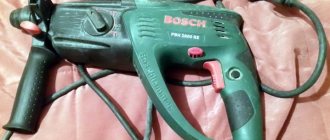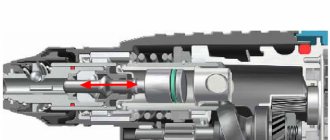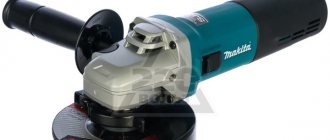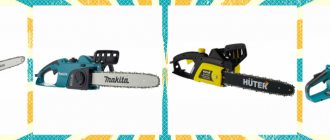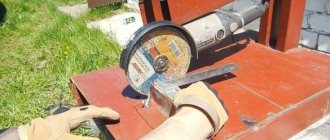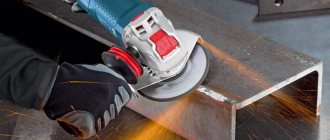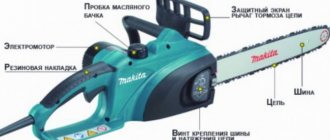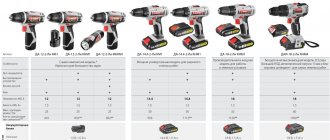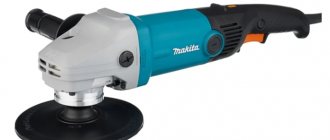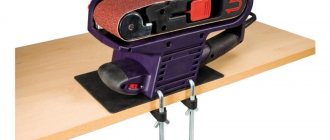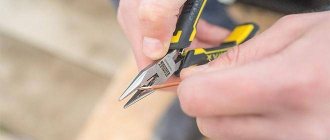Which drill is better, bison or interskol?
For many workers, a drill is an essential tool to have for both household and professional work.
Such a tool should not only be reliable, but also practical to use. There are many types of drills. The choice of drill will depend on the purpose and specifics of the work, technical characteristics, as well as a set of built-in functions, which include the presence of impact and rotation speed adjustment.
All drills are divided into professional and household classes. Drills come in impact and non-impact types. An impact drill is universal because it can be used to work with different materials, for example, concrete, wood, stone, brick, plastic. This became possible thanks to the switchable impact function, without which it would be problematic to work with many materials, for example, concrete, stone and brick. To perform high-precision work, experts recommend using hammerless drills.
When choosing a drill, the manufacturer will play an important role. Many people are interested in the question of which drill manufacturer would be better: Interskol or Zubr.
Zubr is one of the few manufacturers of high-quality power tools in Russia. When developing models, a number of nuances are taken into account, including the ability to work with different materials, the ability to work at low temperatures, and much more. It’s good when a drill can perform several tasks, for example, it can turn from a door into a screwdriver, mixer or hammer drill. Nozzles and drills can be sold as a set or at retail.
Interskol drills are characterized by excellent ergonomic characteristics and well-thought-out power for various purposes. Drilling with such a tool will be not only convenient, but also reliable. All drills are equipped with a rubber gasket, which is designed to prevent slipping on the handle. Many models have a built-in drilling speed control function.
Tools from the manufacturer Interskol have a high build quality, as well as all component materials, and both amateurs and professionals will be able to choose the most suitable option for the job. It is worth noting that the most critical parts are made of special alloys. All tools from Interskol have certificates confirming product quality. The developers paid special attention to the design of their products, since it will be much more pleasant to work with a tool that not only looks good, but also fits comfortably in the hand.
Better corded drills and screwdrivers of average cost: from 1,500 rubles.
Here 3 models stood out, although their power is not the highest. The leaders were products from the brands Interskol, Hitachi and Makita. Devices of this price are characterized by greater freedom of speed adjustment and ergonomics.
Interskol DSh-10/320E2
This is a two-speed tool that operates at 320 watts. Despite the small numbers, it passes through the densest wood and thick sheets of metal without any problems, creating a hole with a diameter of 20 mm and 10 mm, respectively. This is slightly lower than competitors. In one minute, at the first speed, the cartridge makes 400 revolutions, and at the second – 1800. According to these indicators, this model is the undisputed leader. In reviews, users complain about the short power cord, the length of which does not exceed 2 m. The adjustable tightening torque positions are 20 + 1 (21), which is less than usual.
Advantages:
- Services respond quickly to breakdowns;
- Good ergonomics;
- Rubberized handle;
- Replacing brushes on the motor without opening the housing;
- The cord is flexible.
Flaws:
- There may be a slight axial play on the chuck;
- The cartridge does not clamp well;
- The power cord is not very long;
- No storage case.
Cost – 2100 rub.
Rating on a 5-point scale: 4.6.
Here you can download instructions for using Interskol DSh-10/320E2.
Review and testing of the Interskol DSh-10/320E2 model in this video:
Hitachi D10VC2
This is one of three impact drills in our rating; it drills wood, metal, and walls equally well. There is only one speed, but a decent one, 2300 rpm. This model can be used as a screwdriver with a speed limiter and reverse, but there is no clutch here, so you can break the screw. It easily adapts to the desired material, since the rotation speed here can be adjusted in 24 variations. The cartridge clamps tightly, without play. Since it is quick-clamping, the equipment can be changed without problems at any time. Maximum comfort when using it is provided by an additional handle, which can be fixed in a special hole in the body.
Read also: Oil burner for the stove
Advantages:
- High-quality assembly;
- Ergonomics;
- Low noise level;
- Comfortable;
- Light weight;
- Simple reverse operation.
Flaws:
- Small cartridge diameter;
- One speed;
- Lack of coupling;
- Hard cable.
Cost – 3350 rub.
Rating on a 5-point scale: 4.7.
You can read more detailed specifications of the Hitachi D10VC2 here.
Makita DP 4001
This is the heaviest model in the rating, weighing 2.4 kg, which makes it difficult to maneuver. The standard quick-release chuck allows you to securely and quickly fix screws. In poor lighting it is inconvenient to use, since there is no backlight. The cable is also not very long, but this is overshadowed by the high power of 750 W and the large drilling diameter, both in wood (up to 3.8 cm) and in metal (1.3 cm). The spindle speed is low - up to 950 per minute. For safe operation, the cord is double insulated.
Advantages:
- Additional handle;
- Powerful;
- Large drilling diameter;
- Wide range of chuck-clamped accessories;
- Bracket for fastening.
Flaws:
- Uncomfortable in the hand;
- High noise level during operation;
- Not a very long cord;
- Heavy;
- Gets hot when used for a long time.
Cost – 12,900 rubles.
Rating on a 5-point scale: 4.8
Makita DP 4001 is the most expensive model in our rating and, according to user reviews, the most popular among professionals.
The parameters declared by the manufacturer Makita correspond to reality, see this video:
Other best drills can be found in another of our ratings. Here you can find angular, diamond, hammerless and impact models from well-known manufacturers.
So, let's begin.
Previously, I, like most, tried not to overpay for an instrument. Don’t overpay, I mean I didn’t buy famous brands. Assuming they are not unreasonably expensive. but over time, with constant manual work, the need for one or another tool arose, and I was faced with the question of what to buy so as not to make a mistake. “Interskol seems okay, but the stavr is even cheaper, etc.”, perhaps I would have continued to buy various budget instruments if at that time the girl, now my wife for a long time, had not given me one very useful gift for birthday. This was the first screwdriver of the famous Makita brand in my life. This little guy has endured many hours of hard work. I used it to turn everything, both wooden fences and corrugated sheets, it is still in service and in good working order.
Having tried the quality, I didn’t want anything else, and therefore, when the need arose for a more powerful screwdriver, I knew which way to look. I purchased a Makita 456 series, 18V with 2 batteries with a capacity of 3 Ah... from that moment I became hooked on this tool. And not just this brand, but a battery-powered one.
Author's SPV PROJECT
Many people are probably already writing comments - “Nonsense” =), etc. “Why overpay?!” “custom article” =))
But I will continue and tell you why exactly the Makita LXT 18v battery and nothing else! I will try to be brief and constructive.
1. This is the quality of the tool. It makes no sense to talk much about this, since almost everyone who does something with their own hands has heard only positive reviews about this brand of tool. This is a truly high-quality and reliable tool, time-tested.
2. For me, a huge plus is the opportunity to buy only the “carcass” tool itself, without the accompanying batteries, charger, suitcase, because The LXT line provides that the battery will fit any 18-volt tool with this marking. And this is just great, because the cost of the tool is reduced significantly. And having bought a set with 2-4 batteries once, you don’t have to bother and take only the “carcasses”. This way you can assemble a universal set of tools to complete your tasks. Why the more budget-friendly versions of the tool don’t do this remains a question...
3. Complete refusal of wires. Which in turn makes the work easier and faster. No need to look for a power source, unwind the extension cord, then constantly trip over it... oh, I went through this stage. And what about the tangled wires in the bag... Now I put the necessary tool in the bag,
I take it in one hand with all the necessary “carcasses” and consumables,
4. Fast battery charging. It's just magic. The battery charges in about 25 minutes. Why are other manufacturers so slow to achieve this? During this time, it is not realistic to drain all the batteries, no matter what you do. Therefore, 4 batteries with a capacity of 3 Ah are just for the eyes. If I work alone, then they last me all day without recharging.
5. Mobility and autonomy. I'll tell you with an example. Before building a mansard roof (links to the construction site will be below), I had a question about purchasing a hand-held circular saw. Accordingly, I chose the battery option. This option simplified my work significantly. While sawing something while sitting on the roof, climbing between the rafters, racks, supports, I simply could not get enough of this purchase, imagining how I would dangle with a carrier if I bought a wired analogue. And there are many such examples.
6. This is simply a huge range of tools for this battery. See for yourself. Every master will find the right tool for himself.
I’m probably overly praising this line, but this is a sincere sentiment on this matter.
There is also a HUGE disadvantage to this line!
Everyone knows it or probably already understood it while reading it. This is of course the price. It is not sky-high, but quite high.
I would like it to be smaller, but you need to understand that you have to pay well for good things. In addition, I noticed a trend in the market that previously unknown brands like ZUBR, etc., without having proven themselves to be quality, came very close to the price tag of reputable brands. With such a small contrast, I think it makes sense to add a couple of tr. and purchase a worthwhile tool that will serve faithfully for many years.
I'm not saying the other tool is bad. I myself have instruments from other brands, in particular network ones. Which remains from the beginning of my career. But this is more heavy artillery, which goes into battle very rarely. For example, a huge stavr hammer drill, a 235 interskol circular hand saw, etc., a tool that is not needed for everyday tasks. Now I don’t change my favorite brand.
Which corded drill/driver is better to choose?
First of all, you need the reverse button to be in an accessible place and work the first time. If the tool will also be used as a drill, then it should have at least two speeds, preferably with smooth adjustment. For those looking for a universal device, a model with a quick-release chuck is suitable. For night work, backlighting may be useful.
For each purpose, we can recommend a different option:
- For those chasing high power, the Makita DP 4001 is suitable.
- For frequent use, “Hitachi D10VC2” will be relevant.
- Interskol DSh-10/320E2 can handle work at home.
- To carry out major repairs, you cannot do without the ZUBR ZSSH-300-2 model.
- For minor repairs, you can limit yourself to the devices “Diold ESH-0.26N” and “Stavr DShS-10/400-2C”.
If you choose the best corded drill/driver, you can greatly simplify your life and speed up repairs or construction. With it, only a few seconds separate you from the desired hole in the surface and the screwed in screw!
Nickel-cadmium batteries are accused of a lot of things! They say that the size and weight are large, the capacity and power, on the contrary, are low, harmful to nature, the technology is outdated, the memory effect again... However, neither nickel nor cadmium is in any hurry to give up their position in the power tool market to modern lithium with its trusty ion.
Many consumers continue to “vote with rubles” and other world currencies for cordless tools with NiCd batteries. Why is this and what can he really do? Let's figure it out in practice.
In fact, nickel-cadmium batteries have several undeniable advantages.
First of all, they are cheap.
Secondly, for many people what was said in the first place will be enough.
Thirdly, such batteries are unpretentious, i.e. they can be stored for as long as desired with any degree of charge. If you leave a Li-Ion discharged almost to zero on a shelf in the closet, then after a while it will turn out to be inoperative, you will have to take the device to a repair shop or buy a new one, by the way, for a lot of money. By the way, talk about the impossibility of bringing such “patients” back to life is nothing more than a myth of cunning (or simply incompetent) service specialists: there is a fairly simple method for solving such a problem, but more on that another time. So, NiCd is absolutely not afraid of long-term storage with zero charge.
Fourthly, nickel-cadmium is able to function normally at very low temperatures, even in outer space (and this is not a joke, it is exactly what is used there). Lithium-ion “gives up” already at -5°C, although the most modern models of lithium batteries can withstand up to -15°C, which is also quite warm weather, especially in the northern regions. In the cold, you have to work only with nickel-cadmium. This means he still has gunpowder in his flasks!
Need an introduction
If you are going to test two-speed drills and screwdrivers in the price category from 2500 to 4500 rubles. with NiCd batteries with a voltage of 14.4 V and a capacity of 1.2–1.5 Ah, we pursued several goals at once:
• check what modern relatively inexpensive models are capable of;
• find out how true various statements about the advantages and disadvantages of this technology are;
• if possible, confirm or refute some statements regarding nickel-cadmium batteries.
Seven products from six well-known brands took part in the tests: Interskol (two new models at once), Zubr (this copy is also declared as a new product), Stavr, Defort, Hyundai and Stomer (the only professional-class tool that fits into designated price ranges). The characteristics of the presented samples (in ascending order of average cost) are given in Tables 1 and 2.
First, let's study the batteries, because this is precisely why the test was started. It would seem that in our age of high technology, manufacturers have long abandoned the use of archaic chargers (chargers) without auto-shutdown and even without an end-of-process indicator, and have also long removed from their range models whose charging lasts an unacceptably long 3–5 hours. Nothing like this! Such apparently historically valuable examples are available from the Zubr, Defort and Hyundai brands. It's time to look at Table 3.
Myth 1: the longer the better
Manufacturers claim that charging with low current (namely, this is the root cause of the unpleasant “drawn-out” process) increases the life of the battery and allows it to charge better - here we mean increasing the charge density to the possible maximum, in other words, the longer the battery is charged, the more energy it accumulates. This, by the way, is initially untrue, even in theory. NiCd batteries prefer fast charging and slow discharging to zero (or close to it) - this is the ideal mode of their operation, everything else is fiction and a way to reduce the price of the tool by equipping it with the cheapest possible standard charger. Shall we check? Well, to calculate the number of recharge cycles, it would take almost a year of hard work around the clock, let’s put this question aside for now. But it’s quite possible to philosophize about the amount of energy accumulated over 3–5 hours.
Let’s not delve into the physics of the process and the nuances of the ongoing chemical reactions; let’s turn to harsh practice. Table 3 clearly shows that the record for the duration of continuous operation without load (56 minutes) belongs to two participants at once - models from Hyundai and Interskol of the new compact C2 series. The first gets a full charge in 5 hours, the second copes with the same task in 1 hour (plus or minus a couple of minutes). And if you can’t see the difference, why charge longer. Moreover, sitting next to the chronometer in your hands: there is no automatic shutdown, and leaving a nickel-cadmium battery in the charger for more than 8 hours is categorically not recommended - it will deteriorate (tested from my own experience).
Let’s take a look at a couple of the shortest-lived samples – “Bison” and Defort, which worked idle for 36 and 35 minutes, respectively. Yes, everything is clear here: the batteries have a lower capacity (1.3 and 1.2 Ah) than those of other drills and screwdrivers presented. But if you introduce a correction factor and, using simple mathematical operations, recalculate the operating time of these two participants as if they had 1.5 Ah batteries, then when tested without load, the Zubr will still remain in honorable penultimate place, and Defort will rise to 3rd position from the end of our unique ranking. What changed? Almost nothing.
Read also: Frequency of sharpening chainsaw chains of the Ministry of Emergency Situations
It remains to deal with “Stavr”, also included in the list of the “shortest” workers: a 1.5 Ah battery rotated its spindle for only 36 minutes. The secret lies in the fact that in addition to the actual amount of energy accumulated in the battery, the operating time of the tool is influenced by the efficiency of charge use, the design of the gearbox and a bunch of other factors. Cheap electric motors with low efficiency (they consume per ruble, rotate for a penny) have not yet been canceled, as well as microscopic savings on lubrication in the gearbox. Obviously, exactly the same situation arose with “Stavr”, and the following fact can serve as proof: the temperature on the metal (I wonder why?
to dissipate heat?) the rear clutch of the chuck of this drill-driver, after a little more than half an hour of “buzzing” at idle, rose above 60 ° C - measured with a contact thermometer. This means that the spindle gets very hot.
Diagnosis? Complete lack of lubrication in the mechanism, there are no other versions. Now the low duration of continuous operation on a single battery charge becomes clear: the lion's share of the energy accumulated there is wasted in order to overcome the friction force in the “dry” gearbox. I would like to give a caustic comment, but perhaps it will be unnecessary.
Thus, in the case of the 7 presented models of drills and screwdrivers, myth 1 can be considered dispelled.
Myth 2: you need to “rock it”
There is a belief among users of cordless tools that a new battery definitely needs to be “boosted”, that is, until it goes through three full charge/discharge cycles (some say five or even seven - who has more?), “banks” will not reach maximum capacity. Moreover, this condition is especially relevant for nickel-cadmium. Yeah, let's check it out.
The technology is simple: we take the battery supplied with each test participant, completely discharge it, charge it again and record the operating time of the tool while idle, repeat the procedure exactly 10 times and enter the results (rounded to 1 minute) in Table 4.
The myth again split against the harsh truth of life. Absolutely new batteries, taken out of a sealed package, flatly refused to “sway” after three, five, and even seven cycles, and the eighth, ninth and tenth control attempts only confirmed what was said. Skeptics will note that the duration of work without load is not an indicator at all and does not prove anything at all! Let’s not argue, because we still have in stock the second, still completely new, batteries from almost every (except for the Zubr) set, right? Let this trump card lie in your sleeve for the time being and appear when the time comes for testing under load.
Summary: Myth 2 was not confirmed; the capacity of nickel-cadmium batteries does not change significantly during the “boosting” process.
Myth 3: rapid self-discharge
It is estimated that unused nickel-cadmium batteries lose about 20% of their charge per month. This information, although it does not particularly sin against the truth, is still very approximate and general in nature. The speed of self-discharge depends on many factors, including the manufacturing quality of each cell individually and the battery as a whole, as well as its storage conditions. As strange as it may sound, the colder it is, the slower NiCd batteries drain. If we assume that the above 20% per month is lost at room temperature 25 ° C (apparently, this is the case), then, for example, at 0 ° C the charge will disappear approximately twice as slow. Hence the advice: abstract from the comments of numerous “experts” from Internet forums (links to personal experience are good because you can’t check its presence in any way) and store the nickel-cadmium tool in the cold, which it is not afraid of anyway.
In theory, an “ideal”, i.e. absolutely sealed, never used NiCd battery of the highest quality loses a little more than 10% of its charge in the first month of storage at a temperature of 20 ° C, after two months - almost 20%, after three - about 25 %, after six months - from 35 to 40% (everywhere we mean from the initial level). As you can see, the self-discharge process is not at all linear. But this is in theory, but what in practice?
Unfortunately, there was not the slightest opportunity to extend the testing for six months or at least three, or even two months, in order to provide more or less accurate data on the ability of nickel-cadmium batteries of specific models to retain a charge. We had only two weeks at our disposal, one of which had to be spent testing the presented tool for a number of other parameters. For the remaining 7 days, the fully charged batteries lay peacefully on a shelf in a room at a temperature of 25 to 28 ° C, at the end of the specified period they were connected to the appropriate drills and screwdrivers, after which the devices were tested for continuous operation. The results are in Table 5.
There were outright outsiders here: the battery of the “Stavr” model had the highest level of self-discharge, followed by a small margin by the participant under the “Zubr” brand. The remaining copies showed approximately the same results, and the leaders of the rating were Hyundai and Interskol compact series C2. However, it is impossible to draw any final conclusions from the results of a single attempt - well, perhaps, except for one thing: nickel-cadmium batteries do have self-discharge, and it is significant. Thus, myth 3 turned out to be absolutely true. Well, in the sublunary world there is and never has been anything ideal.
Myth 4: memory effect
Unfortunately, this is not fiction. Nickel-cadmium does suffer from memory effects. The most successful and accurate definition of it is as follows: reversible loss of battery capacity as a result of violation of the recommended charging mode. The bottom line is that NiCd batteries cannot be recharged; before installing them in the charger, they should be completely discharged and cooled down - this, by the way, is a prerequisite; let them “rest” for at least 20–30 minutes, depending on the ambient temperature. However, the manifestation of the memory effect during the tests was not studied in any way, so we will leave it without comment.
Read the operating instructions for drills and screwdrivers, the section “Charging batteries” or something like that.
Everyone to the stand!
It's time to arm yourself with measuring instruments and see how true the technical characteristics of the tested drills and screwdrivers declared by the manufacturers are. All the results obtained are included in table 6 , and the real values of torque, which many brands love to overestimate, are additionally presented in diagram 1. By the way, a stand for measuring this parameter was kindly provided.
Models from Zubr and Stavr again disappointed, not even close to confirming their theoretical 28 and 23 Nm, respectively.
In addition, the Stavr also has idle speeds lower than promised - apparently for the same reason as the lack of lubrication in the gearbox. The manufacturer of the Defort drill-driver slightly underestimated its actual weight, although only by 80 grams, which is extremely insignificant. The torque confirmed in practice for Stomer turned out to be as close as possible to the declared one, and other manufacturers, obviously, in the specifications indicated not the “hard” but the “soft” value of this characteristic, hence the noticeable discrepancy, however, in the right direction: they expected less, got more .
From numbers to screws
The rather high developed torque openly provoked testing in operation under extreme loads. Given: pine beam 100x150 mm and three dozen screws (caps) 8x150 mm with hex heads for seventeen.
Task: to find out whether the presented drill-screwdrivers are capable of driving such powerful fasteners into the specified piece of wood without preliminary drilling, which, admittedly, they are not designed for tightening (see the operating instructions for each model), and if so, for how many screws Is one battery charge enough? The answer is in table 7 .
Actually, no surprises happened. “Stavr” habitually failed this test, “Bison” seemed to have started well, but quickly lost torque and after the 7th wood grouse it stopped coping with the task, although there was clearly still some charge in the battery. The Defort model was enough for 14 screws, but let us remind you that it has the least capacious battery (1.2 Ah): if you enter a correction factor and perform a couple of simple manipulations with the calculator, it turns out that with a capacity of 1.5 Ah this participant would have screwed in 17.5 capercaillie, coming very close in results to the Interskol DA-10/14.4M2 model with its 18 pieces. Pure theory, of course, but very similar to the truth. But the three leaders (Hyundai, Stomer and Interskol DA-10/14.4С2) are ahead of the other contenders by a noticeable margin, and you can’t argue with that.
Read also: How to crimp a 4-wire network cable
And now the promised trump card from the sleeve. The fact is that during extreme tightening of wood grouse, both batteries were used from the kit of each drill-driver (“Zubr” was an exception): one “boosted”, and the second – completely new, charged for the first time. In both cases, the number of “defeated” screws was almost the same, with an extremely insignificant difference. For example, Hyundai tightened the 26th screw on the first battery to about halfway, and on the second (new) battery almost to the very end, only a little more than a centimeter was missing. A similar picture was observed with the Interskol DA10/14.4M2 model, and the remaining participants showed the opposite result, when the first battery worked ten seconds longer than the second under load. This once again proves that there is no need to waste time and specifically “boost” the nickel-cadmium batteries of a newly purchased tool; no noticeable effect will follow.
Who is better?
Despite a certain external similarity and a slight difference in cost, it is hardly possible to call the presented models the same. The Stavr and Zubr drill-drivers have frankly “inflated” technical characteristics; moreover, work under load for both of them was accompanied by the appearance of smoke from the ventilation holes in the area of the electric motor, as well as a noticeable smell of burnt plastic and overheated insulation. To avoid disappointment, it is better not to mess with these products.
A couple of models showed average results - we are talking about Defort and Interskol DA10/14.4M2. By the way, after tightening the specified number of screws, they retained a significant torque, but not enough to effectively tighten 8x150 mm fasteners without pre-drilling, which, however, will most likely never be required from 14.4 V nickel-cadmium cordless drills and screwdrivers . In general, these specimens are quite worthy of consumer attention, and their prices are attractive. Finally, the three obvious leaders are Interskol DA-10/14.4C2, Stomer and Hyundai, undoubtedly the best models among the presented specimens, maintaining maximum torque until the battery is almost completely discharged, which indicates the most efficient use of charge. Very well made models, supplied in convenient cases and definitely recommended for purchase by DDD magazine.
Grinders (aka angle grinders) are extremely in demand in households and small workshops. But you will have to choose these devices as pickily as possible. They also require proper handling.
What is the difference between Interskol and nonnames like Sturm, Brigadier, Einhel, Zubr, etc.?
I already have Interskol electric tools for household purposes. None of them have failed yet. But I asked myself: is Interskol any different from the Chinese non-names like Sturm, Energomash, Elektromash, Zubr and other twin brothers, apparently created at the same “factory”. I want to know if IS is the same Sturm, etc., or is it at least one step higher than those listed? Or is it made from the same components? I wondered because Interskol often has the same appearance as those listed above, so maybe it’s the same inside? So why then overpay the extra hundreds of rubles?
TODAY I AM ASHAMATED TO BE UKRAINIAN!
Well, these are all words, why do you need them? Buy a heel of instruments from each brand you specified and come back in a couple of years - you’ll tell us everything yourself. The components are different.
Vlad_power wrote: . Interskol often has the same appearance as those listed above, so maybe it’s the same inside? So why then overpay the extra hundreds of rubles?
It used to be that the nameplates were re-glued, until 1995. approximately. Nowadays, trading companies order tools with clearly defined specifications, and they are made in batches. the same bearing can cost 40 rubles, or maybe 600 rubles... and all this affects the final price. For an instrument, the difference of “hundreds of rubles” is insignificant; it is not purchased so often.
I heard an interesting opinion today from a saleswoman from a tool store. Her husband rolled up a cart with a whole arsenal of “Foreman” tools. Unloads slowly. I asked the girl how the “Foreman” was in terms of quality. She laughed and said - it’s better to buy Interskol. “Foreman” is for retired grandfathers who suddenly decided to attach a shelf for their grandmother, sharpen knives in the kitchen, or drill a couple of pieces of wood in the country. And nothing more. The only advantage is the low price. But essentially a disposable tool, if it breaks, just throw it away and buy a new one.”
Ledogor wrote: But about the fact that the tool is disposable, if it breaks, just throw it away and buy a new one.”
I personally replaced the eccentric grinder twice under warranty for 250 rubles with a new one. In Leroy. They didn't even bother opening my box to see what was inside!
So, as for the trash heap, this is a very controversial issue.
In general, I am engaged in the construction of websites and online stores.
I have several interskol tools. I use it for domestic purposes while I’m still alive, I recently had a stubble grinder... it worked for 3-4 hours... after the teeth on the gearbox were ground off, I bought new ones on the market, after working it for another half an hour, the silumin housing of the gearbox cracked. it became unsafe for her health to work. didn't touch her anymore. Interskol I think is much better than this stern.
Pekkonen wrote: eccentric grinding for 250 rubles for a new one. In Leroy.
I was recently in Leroy in the Far East looking for a plane and didn’t see such grinders. Otherwise I would have bought it to sand the car for once.
s Sergey S wrote: ..interskol I think is much better than this stern.
Well I do not know. As soon as the first 220V store opened here, it seems in 2005, I bought a Stern flat sander for $10 and it’s still there.
volodrez wrote: well, I don’t know. As soon as the first 220V store opened here, it seems in 2005, I bought a Stern flat sander for $10 and it’s still there.
In general, nothing breaks in a surface grinder, and that’s why it’s alive. Where there are gears, it is better to avoid the stern.
sad throw-in. but people eat it
Pekkonen wrote: Personally, I replaced the eccentric grinder 2 times under warranty for 250 rubles with a new one. So, as for the trash heap, this is a very controversial issue.
Apparently you just like to go to Leroy.
You can't compare brands as such. It is necessary to take and compare these specific models. Each brand may have proven and reliable models, they may be crude and unfinished (as was the case with the two-speed network Shurik from Enkor - the first batch went through all the repairs, and all subsequent ones serve very well), or you may also just get stupid, stillborn models. Each brand may have an engineering service (for example, the same Enkor, a mistake was made, but quickly corrected by identifying the cause and developing a treatment), or maybe only a purchasing department, stupidly ordering Chinese crafts without the slightest modification.
I have neither the right nor the desire to talk about which of the listed brands is which - I won’t tell the truth for everyone, but I won’t lie. I will only emphasize that Prorab is correctly described as one of the most unsuitable. Until I met him, I thought that all Chinese vertical rotary hammers were quite decent and suitable for work, although they were heavy as hell.
Superrat73 wrote: You cannot compare brands as such. It is necessary to take and compare these specific models. Each brand may have proven and reliable models, they may be crude and unfinished (as was the case with the two-speed network Shurik from Enkor - the first batch went through all the repairs, and all subsequent ones serve very well), or you may also just get stupid, stillborn models. Each brand may have an engineering service (for example, the same Enkor, a mistake was made, but quickly corrected by identifying the cause and developing a treatment), or maybe only a purchasing department, stupidly ordering Chinese crafts without the slightest modification.
Brand is nothing, model is EVERYTHING
, unless, of course, all of the above are really brands. p.s. - Enkor is a completely adequate brand.
Mutru4 wrote: p.s. - Anchor is a completely adequate brand.
Not only adequate, but also the father of online Shuriks.
Superrat73 wrote: and also the father of online Shuriks.
Let me clarify, corded screwdrivers with a coupling and light weight, like battery-powered screwdrivers, and before that there were a lot of things
Remaking chargers and more
Interskol is a proven brand over the years. And not in domestic conditions, but in difficult industrial conditions. Grinders Makita 9069 with soft start and Interskol 2000 watts worked simultaneously. They showed themselves to be almost equal, only Interskol changed the brushes, and Makita was damned. But not a single one failed. As for those made in the image and likeness and made who knows where, these are mostly disposable tools for home use, such as drilling a hole, cutting a wire or sawing a board in half. It's good for that, but nothing more. This type of circular saw is lying there, it worked but nothing, the shank of the electric motor armature broke off. The wear and tear on the product itself is minimal, and not only is there nowhere to repair it, there is no service support, it’s also cheaper to throw it away and buy a new one.
Crosser CR8E Mantis TS-350 with Lombardini diesel engine
Pykhtachok wrote: Interskol is a proven brand over the years. And not in domestic conditions, but in difficult industrial conditions.
Gold words. Only different people understand them differently, so after one example you will praise Isovo’s earpieces, and someone who sawed his chest will criticize, and many others who watched the video of one respected forum member from St. Petersburg (about the strength of the rear handles of 230 cars) will think hard about the quality of IS plastic and some others that did not pass the test.
Well, this is who and how it works. I had “specialists” who lost two Hilti rotary hammers in a week, and then said that Hilti was complete G. Fortunately, Hilti now has a lifetime service for all equipment. True, for our money, which we pay upon purchase. But this does not mean that Hilti’s instrument is bad, those who worked with it have bad hands.
Which hammer drill should you choose?
I'm asking for advice, which hammer drill should I buy? purpose of operation: renovation in sq.m (non-commercial use), limited budget.
Do you have any positive or negative experiences when using certain companies? I will be glad for any advice)
-The puncher will choose you.
-But how will I understand this?
-He will try to kill you.
A little advice on how to distinguish a normal hammer drill from a bullshit one.
They all have approximately the same parameters of speed, impact force and power (if you look at different models in approximately the same price range). But finding out the quality of bearings and materials is not so easy.
Therefore, I advise you to choose the most Heavy one! 4.5+ kg. Such models have more massive mechanisms and usually last longer. And it’s also much more pleasant to work with than a 2+kg piece of bullshit.
For ease of work in hard-to-reach places, choose a perf with a longitudinal engine. If you don’t manually destroy, move, etc. walls, openings, ceilings - choose any one, it will be enough for your scope of work. Pay attention to the operating mode switch. Some models do not have a slotting mode, only drilling and impact drilling, they are cheaper, but do not take them.
I have a Makita 2450. Dear, but I did professional installation, and have stayed since then.
Call this mode a professional term!
Minor repairs in three apartments, personal use, not a tool for work
If you don’t gouge the walls, then a Bosch or Makita is fine, I think, I’ve had a Bosch household one for about 15 years now, but the oil has begun to slightly protrude on the body. Usage: Drill a hole for fasteners, basically.
If a drill comes out of their wall, does that mean it’s good?
Well, rather, you need to consult on the level of noise and vibration))) listen to them
Makita, and if you don’t care about money, then a green Boche will be enough for you. I have pbh3000. He is already 6 years old. And the main thing is that the inscription is cast, that is, rubber letters, this will mean that the instrument is not a fake. If it has a sticker, then it's meal. Although my non-original screwdriver has been turning for 5 years, only the chuck hits hard
I took home for 5 thousand, makita company. Good hammer drill.
Repairs vary. Cutting down/punching through is one thing, demolishing a reinforced concrete partition is another. In general, the class of a tool indicates its resource and operating cycle. But even within the class, hammer drills differ, primarily in terms of impact energy.
Repairs vary. Cutting down/punching through is one thing, demolishing a reinforced concrete partition is another. In general, the class of a tool indicates its resource and operating cycle.
I have a blue Bosch for my home. If you are renovating yourself, there is no way in a panel house without perf. In principle, it is possible to drill, beat off tiles, and groove. It's been around for ten years now, I don't know how much it costs now, it used to be quite affordable.
Take the loudest one!
What is this for example? Everything is China.
Here is a review of household hammer drills:
Easier reviews on me. Read the market, and select them according to the parameters.
Yes, I don’t believe it, I don’t believe the store reviews)
Battery and its characteristics
You simply cannot do without a battery. It serves to supply DC power to the motor. The battery is also installed in a small size. This allows you to significantly reduce its weight for ease of operation. This device consists of several power elements fastened together and connected in series.
At the same time, they are all united in a single body, so they appear to a person as a single whole. The range of supply voltages for a screwdriver can be very diverse. It starts from 9 volts for home household models, and can reach 18 volts for powerful professional devices. A direct pattern can be put forward here. The higher the supply voltage, the more powerful the screwdriver itself will be.
So, now everyone knows what components a screwdriver consists of. As you can see, they are all quite simple. Knowing the design of a screwdriver, you can always draw conclusions regarding how it can be repaired. A person who has a strong theoretical basis can always apply it in practice. Repairing a screwdriver with your own hands will always save you a lot of money.
Bring back speech
Hello, Pikabushniki. I have a story.
Two years ago my mother died of cancer. Six months later, my dad suffered a stroke. At the moment he has the first group of disability. He walks, understands everything perfectly, hearing and vision are fine. But a vicious stroke took away the power of speech, but not completely. He can make sounds and say three simple words - “yes”, “no”, “Dima”.
I contacted the city hospital with the question: “Is it possible to restore speech?” To which they answered: “This is impossible.” Personally, I don't believe this. Speech is not completely absent. Perhaps in a private clinic it will be possible to “turn on” or “reboot” the part of the brain responsible for speech.
I would like to know from you. Does anyone have similar cases and has speech been restored? And also, I would like to contact knowledgeable doctors - how bad is it and is it possible to regain speech?
Need help, oncology
Good afternoon. Pikabu people, we need your help and advice. The situation is as follows: my mother-in-law was suspected of having lung cancer and was given a referral to Pesochny. A week before the trip, my legs suddenly give out, we call a therapist and through her we are taken to the hospital by ambulance. There they do an MRI and discover metastases in the lungs and spinal cord, which is what caused the legs to fail. According to the doctor, he will never be able to walk again, he needs to go to an appointment with an oncologist, or call him at home. We made an appointment with an oncologist, but what next? My head is a mess, we don’t understand what to grab onto now. We'll probably need a nurse for the first couple of weeks, then we'll think about something further. I ask those people who have gone through similar moments to respond, I ask for advice and let’s say “step-by-step instructions” on what, where, how to do everything correctly, I’m afraid of losing sight of something. Regarding the diagnosis, I am writing in my own words, the discharge is on Tuesday, then I will be able to more clearly formulate the diagnosis and conclusion. I’m writing here for the first time, I don’t know how to indicate tags correctly, but a rating is not needed. City of St. Petersburg, Kalininsky district.
Help the Labrador
CRF in a dog. Help is needed!
I really need the help of a veterinarian or people who have encountered something similar.
There is a Labrador, an 8-year-old girl. Unsterilized. In April, we were faced with the fact that we were diagnosed with chronic renal failure (CRF).
Doctors said that chronic renal failure developed due to a congenital disease - kidney nephrosis.
At the moment, the dog is deteriorating; drips and alternative therapy in the form of injections and tablets do not help.
The doctors sent him to live while the dog eats and walks on its own.
As a possible support for the current condition, they suggested contacting clinics where hemodialysis is performed. But overall the forecasts are negative.
We are looking for any possible help - advice, consultation from doctors. We have already contacted more than 7 different Moscow clinics.
If your animal had a similar situation, please tell us how you dealt with it. We need any information now.
Exploitation
It is strictly forbidden to work with an angle grinder that has a damaged start button. This may cause the cutting discs to jam. It is advisable to avoid overheating the tool unnecessarily and to use only compatible discs. The lubricant is changed within the time frame prescribed by the manufacturer.
The frequency and duration of breaks during work must be no less than specified in the instructions.
A review of the angle grinder “Bison” USHM-P230-2100 PV awaits you in the video below.
